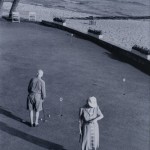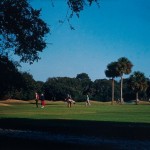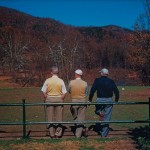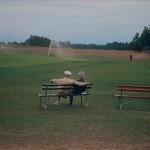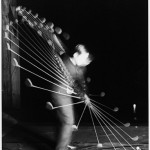May 31 to October 6, 2013
Alcove Gallery
Magill Library
#2 on Campus Map
Summer Hours:
Weekdays: 10 a.m. to 7 p.m.
Fall Hours: (September 2–October 6, 2013)
Weekdays: 10 a.m. to 5 p.m.
Weekends: 12 p.m. to 5 p.m.
The US Open will be played at the Merion Golf Club located across from the
Haverford College campus on Haverford Road June 10th-16th. This golf course has special significance to Philadelphia and to golfing lore. It was here in 1930 that Bobby Jones won the US Amateur Tournament, completing his grand slam. The only golfer to come close to this feat since then was Tiger Woods when he held all four major professional golf championships in 2000- 2001.
This exhibition of 20 black and white and color photographs of golf by Harold
Edgerton (1903-1990) and Walker Evans (1903-1975) is topical because of the
nearby tournament, the subject matter and the history of photography. Harold
Edgerton and Walker Evans, both golfers themselves, are well known in the art
world for their documentary photographs–Edgerton for his high speed motion
studies and Evans for his documentation of the human condition. These differences in approach are manifest when their photographs of golf are seen side by side. Similar questions are raised by golf as a game and as a sport. Is it a recreational activity or a sport requiring rigorous physical and mental training?
Edgerton invented multiple flash stroboscopic photography and used it to answer a fundamental question of golf: “What happens during the ‘click’—that all-important event when the club imparts its energy and the skill of the player to the ball?” The photograph of Bobby Jones’ golf swing is a scientific record. The exposure of the negative at 1/100,000th of a second reveals a swing that is compact and rhythmic, a hitch or hesitation in Jones’ swing would be clearly visible in the photograph. Ultra high-speed photography has become the norm for sports training and motion study today but in 1938, when Edgerton photographed Jones and other championship golfers, it was a first.
Walker Evans’s photographs are meditations on the everyday. It is rare that there
is any action in his photographs including the ones of golf courses published
in a Fortune magazine essay titled, October’s Game. Evans is interested in the
transition of seasons from fall to winter and its effects on a solitary golfer within the landscape. He writes: “The finest of all golf landscapes are created, it would seem, simply by the arrival of fall. On some of the country’s best courses, certain spots, certain chance groupings, certain enchanted moments of the season become indeed classics of their kind, for the eye.”
Harold Edgerton, in his photos, explores , the (previously) unseen physics and
poetry of a golf swing. Walker Evans’ pictures of chance groupings of golfers on
a course in ideal weather create a sensory experience. Edgerton and Evans use
photography to express their interest in the game, which makes it possible for non-golfers to understand its allure. Their photographs are some of the most original made of golf and golfing. These rarely seen photographs will be displayed along with the artists’ publications and writings on the subject.
For more information:
wwilliam@haverford.edu
facebook.com/HaverfordCollegeDepartmentofFineArts
